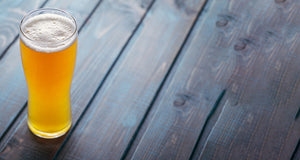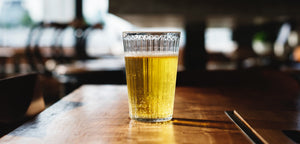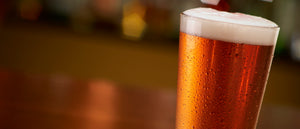Overview
Kvass is a lightly soured beer made from rye bread, sometimes flavoured with fruits or mint. Kvass is required to be less than 1.2% alcohol, and is sold as a non-alcoholic beverage akin to soda. American versions sometimes ferment closer to 4% to remain competitive. Kvass is often compared to Kombucha and other pro-biotic beverages in naturally fermented versions.
Beer Specs
ABV: 0.5% - 1.2%
Colour: Light to Amber to Dark Brown
IBU: 0-1
Recipe
1 gal water / loaf rye bread
33 g / gal base malt
1 IBU boiling hops
Nottingham Yeast (traditionally bread yeast or sourdough starter)
Process
- Cut rye bread into cubes and toasted until golden brown. We used a caraway rye bread from the local Birdie's Bread Co. in Dartmouth, Nova Scotia.
- Soak overnight in 1 gallon of water per loaf of rye bread at 185 º F (85º C). Temperature will decrease overnight. High starting water temperature will kill any bacteria and eventually cool to saccharification rest level.
- The next morning, add bread mixture to mash tun.
- Add 33g / gal base malt.
- Increase temperature to 152º C and mash for 1 hour.
- Vorlauf for 10 minutes and transfer to boil kettle.
- Add 1 IBU boiling hops.
- Boil 60 minutes.
- Whirlpool and transfer to fermentation vessel.
- Ferment at 20º C.
- Due to low starting gravity of the style, the Kvass will reach terminal gravity quicker than traditional beer timelines.
Traditional Kvass is not boiled, left overnight with no hops added, ending to microorganisms responsible for lactic fermentation and does not require additional base malt. Base malt and boil stage were added to make final product more appealing to consumer base.
Origins
While the origins of Kvass are unclear, the notion of accidental discovery is accepted as the founder of the beverage. A farmer in the fields of Russia finds a bag of sprouted grain and turns it into flour, or watered rye bread that has spontaneously fermented. Like many discoveries, the curiosity of the first Kvass drinkers continued the 'I wonder what it's like' tradition, and began the Kvass culture.
However, tracking bread's use as a pre-malting beer base from Mesopotamia, through Armenia and into Russia, a case can be made that Kvass is a sub-category of a larger tradition with rye bread becoming the now traditional choice.
The first record of the Slavic Kvass dates to 996 CE in the Russian texts the 'Primary Chronicles', a history of the Kievan Rus between 850 to 1110 and compiled in 1113. A single reference from page 121 mentions the Kvass:
'With the thought that the weak and the sick could not easily reach his palace, he arranged that (126) wagons should be brought in, and after having them loaded with bread, meat, fish, various fruits, mead in casks, and kvass, he ordered them driven out through the city. The drivers were under instructions to call out, "\Vhere is there a poor man or a beggar who cannot walk? To such they distributed according to their necessities.”'
A Turning Point
In 1972, Pepsi became the first Western product allowed to be sold in the Soviet Union due in part by then President of the United States, Richard Nixon, with payments being made to PepsiCo in the strongest Soviet currency on the world market: Stolichnaya vodka. In response, Kvass became colloquially known as 'Russian Coca-Cola'. Adopting the moniker of the larger beverage company along side the beverage pride of Russia modernized Kvass to the new generation of consumers. Kvass was propelled into stardom as the Russian beverage for the people, by the people, with origins being dispensed from neighbourhood carts into plastic bottles instead of fancy imported aluminium cans.
Bonus fact: A new deal was struck in 1989 as the previous contract expired with Russia paying with military equipment inherited from the Cold War. For a week in 1989 Pepsi owned the 6th largest cache of diesel submarines in world. The equipment was later sent to scrap for PepsiCo to recoup actual currency.
Modern Kvass
Kvass has become a multi-million dollar industry in Russia since the fall of the Soviet Union and influx of Western companies into modern Russia. Initially the increased presence of Western companies negatively impacted Kvass sales. A resurgence of Kvass in the early 2000's caused PepsiCo and Coca-Cola to manufacture their own version. As of 2014 PepsiCo and Coca-Cola respectively hold third and fifth place in Russian Kvass market share.
Advancement in brewing technology evolved Kvass into our modern beverage. While traditional Kvass was spontaneously fermented, or fermented sourdough culture producing the typical sourness, larger scale manufacturers use brewer's yeast to create a consistent, predictable product. Early forms of Kvass saw additions of raisins, mint or lemons; modern additions include strawberry, blackberry, beet, honey and apple. A common mistake is the idea of a 'grain-free' Kvass beverage.
Due to the presence of Lactobacilli bacteria (in spontaneous/sourdough fermented versions), potential health benefits of probiotics, and sourness, Kvass is frequently compared to Kombucha to the extent of these 'grain-free' versions of Kvass being created. A fermented beverage made from fruit, honey, and mint is delicious, though not classified as Kvass. By definition a Kvass is a beverage fermented from bread, traditionally rye bread.
Steve Crane
Brewer. Cellarman. Certified Beer Server.




